
The Amur bitterling is a small fish of the carp family. It is sometimes just called "bitterling", which dates back to the time when the European bitterling was still considered conspecific with R. sericeus, and "bitterling" properly refers to any species in entire genus Rhodeus. The Amur bitterling is found in Siberia, while the European bitterling is found from European Russia westwards.

Rhodeus is a genus of cyprinid fish, consisting of 23 species called bitterlings. The scientific name is derived from the Greek word rhodeos, meaning "rose". Most species in the genus are restricted to Asia, but two species are found in Europe.

The quagga mussel is a species of freshwater mussel, an aquatic bivalve mollusk in the family Dreissenidae. It has an average lifespan of 3 to 5 years.

The banded demoiselle is a species of damselfly belonging to the family Calopterygidae. It is often found along slow-flowing streams and rivers. It is a Eurasian species occurring from the Atlantic coast eastwards to Lake Baikal and northwestern China.
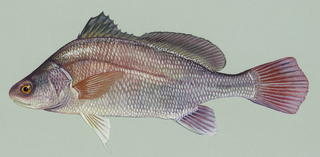
The freshwater drum, Aplodinotus grunniens, is a fish endemic to North and Central America. It is the only species in the genus Aplodinotus, and is a member of the family Sciaenidae. It is the only North American member of the group that inhabits freshwater for its entire life. Its generic name, Aplodinotus, comes from Greek meaning "single back", and the specific epithet, grunniens, comes from a Latin word meaning "grunting". It is given to it because of the grunting noise that mature males make. This noise comes from a special set of muscles within the body cavity that vibrate against the swim bladder. The purpose of the grunting is unknown, but due to it being present in only mature males and during the spawning season, it is assumed to be linked to spawning.
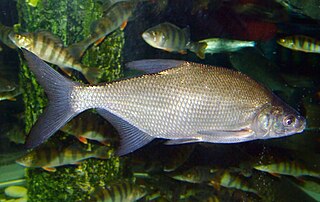
The common bream, also known as the freshwater bream, bream, bronze bream, carp bream or sweaty bream, is a European species of freshwater fish in the family Cyprinidae. It is now considered to be the only species in the genus Abramis.

The freshwater pearl mussel is an endangered species of freshwater mussel, an aquatic bivalve mollusc in the family Margaritiferidae.
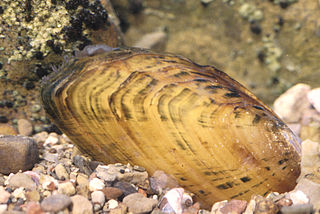
The cracking pearlymussel is an endangered species of freshwater mussel, an aquatic bivalve mollusk in the family Unionidae.

The rosy bitterling or Tairiku baratanago is a small freshwater fish belonging to the family Cyprinidae (carp), native to East Asia from the Amur River basin to the Pearl River basin.

The Kyushu bitterling is a temperate freshwater fish belonging to the Acheilognathinae of the family Cyprinidae. It originates on Kyushu Island in Japan. It was originally described as Acanthorhodeus atremius by Jordan & Thompson in 1914. The fish reaches a size of up to 6 cm (2.5 in), and is native to freshwater habitats with a pH of 6.8 to 7.8, a hardness of 20 DH, and a temperature of 10 to 25 °C.

Light's bitterling is a temperate freshwater fish belonging to the subfamily Acheilognathinae of the family Cyprinidae. It originates in Russia and China, from the Amur River basin to southern China. It was originally described as Pseudoperilampus lighti by H.W. Wu in 1931.
Rhodeus rheinardti is a tropical freshwater fish belonging to the Acheilognathinae subfamily of the family Cyprinidae. It originates in the Perfume River, near Hué, Vietnam. It was originally described as Danio rheinardti by G. Tirant in 1883.
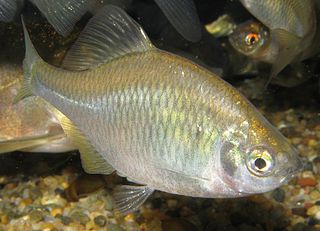
Rhodeus smithii, sometimes known as the Japanese rosy bitterling, Japanese bitterling, or Nippon baratanago is a temperate freshwater fish belonging to the Acheilognathinae subfamily of the family Cyprinidae. It originates in stagnant waters in inland rivers in Japan. It was originally described as Achilognathus smithii by Charles Tate Regan in 1908, and is also referred to as Rhodeus ocellatus smithii in scientific literature.

Rhodeus suigensis is a temperate freshwater fish belonging to the Acheilognathinae subfamily of the family Cyprinidae. It originated in inland rivers in Japan and the Korean peninsula. It was originally described as Pseudoperilampus suigensis by T. Mori in 1935, and has also been referred to as Rhodeus atremius suigensis in scientific literature. The species was listed as endangered in 1994 by the World Conservation Monitoring Centre, but in 1996 was relisted as "data deficient". When spawning, the females deposit their eggs inside bivalves, where they hatch and the young remain until they can swim.
The Albanian barbel is a ray-finned fish species in the family Cyprinidae. It is often referred to as "Albanian barbel" in a literal translation of its scientific name.

The Carolina heelsplitter is a species of freshwater mussel, an aquatic bivalve mollusk in the family Unionidae.

Theliderma intermedia, the Cumberland monkeyface pearly mussel or Cumberland monkeyface, is a species of freshwater mussel in the family Unionidae, the river mussels. This aquatic bivalve mollusk is native to Tennessee and Virginia in the United States. Historically widespread in the upper Tennessee River system, it populations have been reduced by habitat destruction and pollution. It now only occurs in two tributaries: the Duck and Powell Rivers. It is a federally listed endangered species.

Acheilognathus macropterus is a species of cyprinid fish native to China and northern Vietnam. It grows to a length of 27.5 centimetres (10.8 in) SL.

The Tokyo bitterling is a temperate freshwater fish of the carp family (Cyprinidae). Taxonomically, it belongs to the subfamily Acheilognathinae.
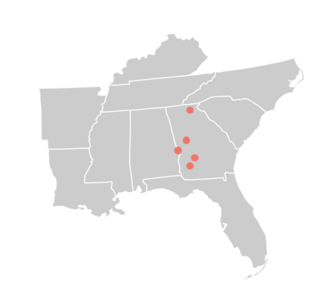
The Halloween darter is a small freshwater fish native to North America. It is found in Georgia and Alabama in the drainage basin of the Apalachicola River, specifically in the Flint River system and the Chattahoochee River system. It prefers shallow, fast-flowing areas with gravel bottoms in small and medium-sized rivers. It was first described in 2008, having not previously been distinguished from the Blackbanded darter (P. nigrofasciata), formerly thought to occur in the same watershed. Blackbanded darter has since been split again with Westfall's darter now recognised from the Apalachicola drainage. The species is somewhat variable, being generally blackish dorsally, with some individuals having indistinct saddle-like barring. Males have orange and dark lateral striping while females have dark stripes and a yellowish-green belly. At a maximum standard length of 101 mm (4 in), males are slightly larger than females, and both sexes develop distinctive orange barring on the edge of the first dorsal fin during the breeding season.




















